Running the Marabana, a marathon like no other
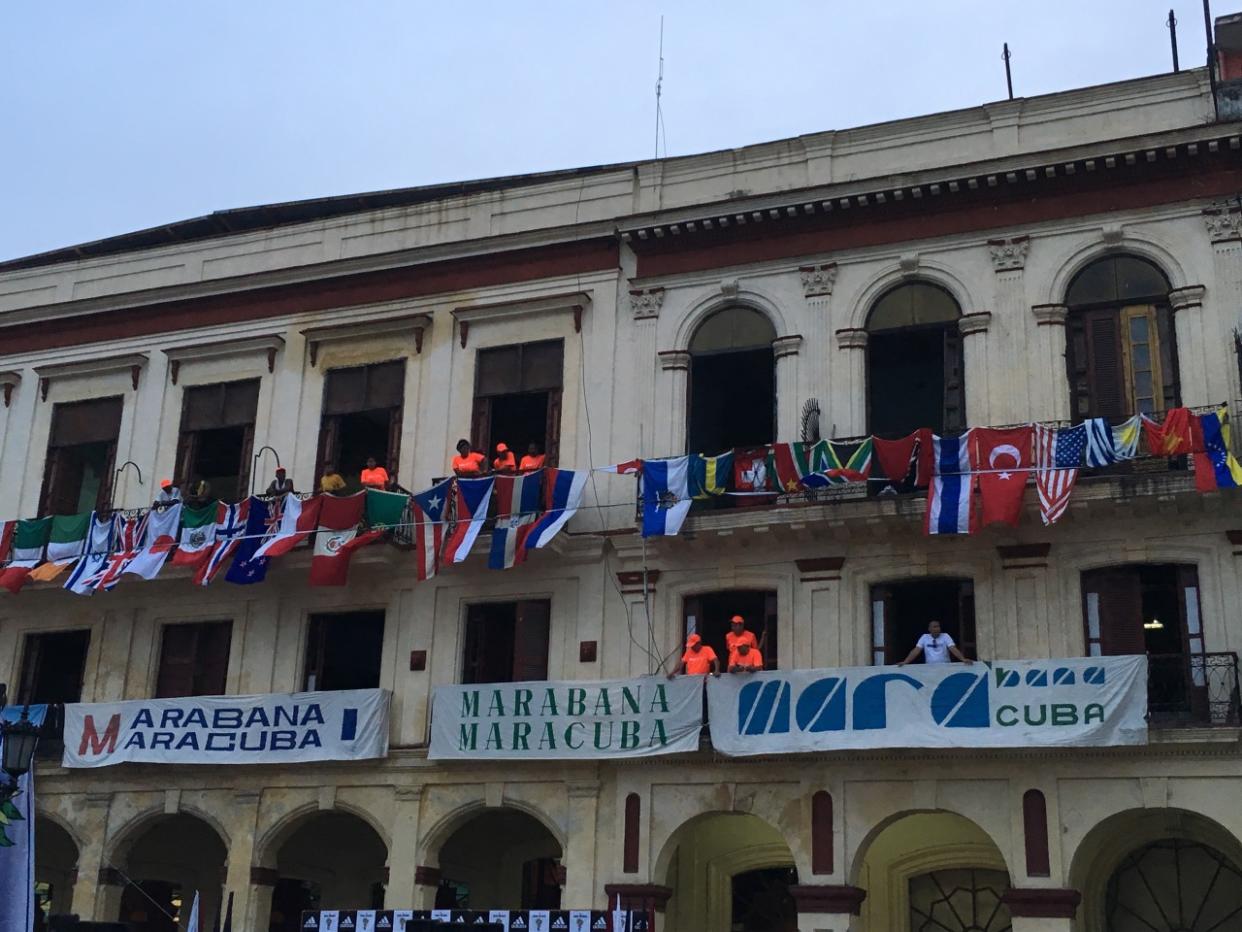
Banners and flags hang from a building near the start of the Marabana Cuba. (Photo: Lauren Johnston/Yahoo News)
HAVANA — The sky is just turning pink. It’s barely 6:30 a.m., but the temperature has already passed 80 degrees and I am following the silkscreened face of Che Guevara staring out from the back of a runner’s singlet and leading me toward the start corral of the Havana marathon.
A man dressed all in white — the uniform of Santeria devotees — is singing a rhythmic, a cappella Cuban rumba on a stage near a balloon archway printed with the name Marabana Cuba that marks the start and finish line. It’s a play on words: Marathon + Habana = Marabana. Normally I’d reach for my phone to Instagram a moment like this, but of course I don’t have cell service or Wi-Fi here.

Havana is a study in ruin and renovation. Near the start line, runners negotiate the debris of a collapsed building. (Photo: Lauren Johnston/Yahoo News)
I have waited months to be here in Cuba at the start line of this racecourse, a wide loop that winds down the historic avenues of Old Havana, courses through blasts of sea spray along the iconic oceanfront roadway, the Malecon, and then veers inland barreling toward the interior neighborhoods of Central Havana — parts of the city most tourists will not see and that for decades Americans have not been permitted to visit.
SLIDESHOW: Running Havana’s “Marabana” >>>
Half marathoners will run the loop once. The considerably smaller field of runners tackling the full distance — 380 out of 3,635 — will cross the finish line with them, then push through for an encore loop. I’m already steeling my mental game for that moment. It won’t be easy to run past the finish line after slogging through 13.1 miles in this heat and humidity, then gear up to do it all again. This is my sixth marathon and for the first time, I’m packing a small bag of rock salt to replenish what I lose in sweat. I’ve never run a marathon in heat like this.
For now, the scene before me is a kaleidoscopic sea of rainbow tech shirts and more of those Che Guevaras. The runners here hail from 64 countries, and teams from both Denmark and Puerto Rico have tanks printed with his portrait — the revolutionary as race mascot. Amid all the high-tech race gear worn by foreign racers, there are also runners wearing street clothes, flat canvas sneakers, sandals and a few with no shoes at all.
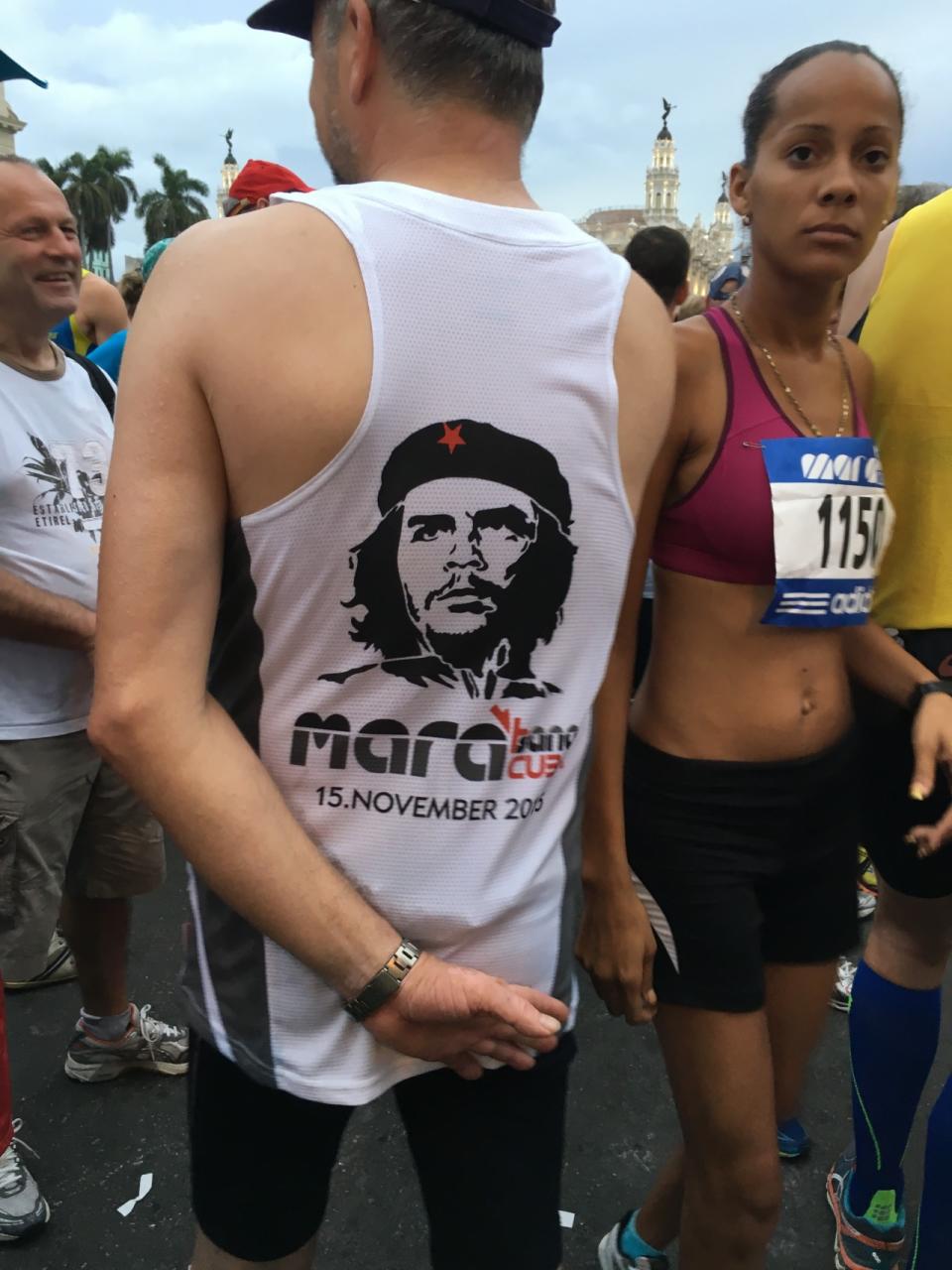
The face of revolutionary Che Guevara appeared on many runner singlets, like this one from Denmark. (Photo: Lauren Johnston/Yahoo News)
Julio Travieso, the Cuban native, now Florida resident, who organized my trip, talked a lot about shoes before we made this journey. Though the quality of life is improving, Cuba is still a very poor country, and running shoes are expensive and also in short supply. “The shoes [are] a big thing. People will ask you about your shoes,” he said.
The first person to do so is a Cuban man in running shorts and a race bib who looks to be in his 70s. He stopped my group, the Hot Tamale Runners, as we crossed through Havana’s Parque Central over to one of the city’s majestic main thoroughfares, the Paseo de Martí, en route to the start. He pointed first at our shoes then his and speaking rapidly, held up a worn sneaker and shook it to show the back half of its sole flapping slightly.
“Que he tenido estos zapatos durante 10 años,” he said emphatically. “I’ve had these shoes for 10 years.” I couldn’t translate everything, but I could tell the durability of the shoes and the fact that he’d taken care to make them last so long was a point of pride. They had to last.
One long look from left to right at the race start line captures a lot about the state of Havana right now. To the left, the old National Capitol Building, a near clone of the U.S. Capitol, is undergoing a massive restoration. El Capitolio housed Cuba’s Congress until 1959 when Fidel Castro’s rebels dismantled the government and denounced the building as a symbol of corrupt U.S. dealings. Now, with President Raúl Castro’s blessing, the big marble building is set to reclaim its role as the center of Cuba’s government, a symbolic crumbling of the old regime.
To the right, the crumbling is literal. There is a large concrete and plaster pile that used to be a building. Runners, ever resourceful, are using the bigger chunks as calf-stretching props. This juxtaposition of new and old, or infrastructure and no structure, is everywhere.
Cuba is a country in transition, with a green light for change that’s happening only in pockets, and slowly. President Obama cracked open a 50-year time capsule last December when he announced his plan to reestablish diplomatic relations. These runners represent the opening up and are proof that change is coming.
“The hope of better times coming is the biggest change in Cuba that I see today. They’re more optimistic, even though not everyone is benefiting yet,” Travieso told me in a phone interview ahead of our trip.
“I think the fact that you are Americans and that you are here is extremely important to [the Cuban people] because it validates what they have been reading in the newspapers. Even if they don’t benefit directly from you being here, there’s hope. Tourism trickles down. The taxi driver gets a nice tip. The guy who works in the hotel gets a nice tip, but the person who sells cookies in the street will benefit because the guy who drives the cab can now afford to buy them,” he said.
The race, and the bigger spotlight on it this year, is a big deal for Cuba, Travieso said. “This is not just New York or not just Boston, this is a whole country that is putting its face out there.”
This year’s field is the biggest this race has seen in its 29-year existence. There are a record 1,582 foreign runners, 582 of them Americans — the largest number ever. That is due to Obama’s relaxed rules that allow Americans to travel to Cuba on “people-to-people” visas versus licenses issued through the State Department.
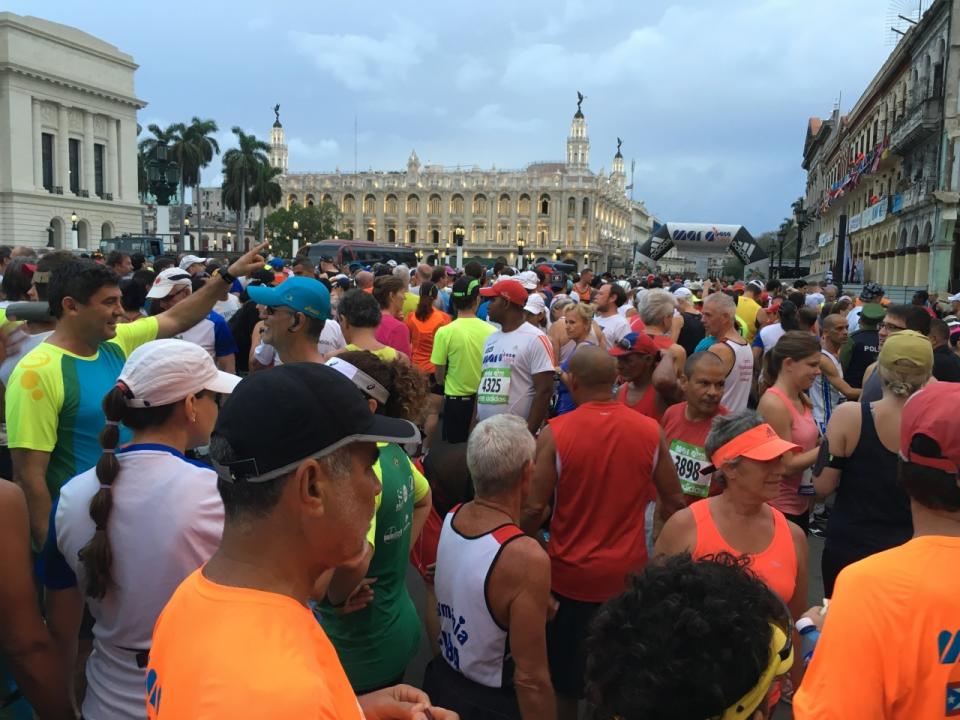
This year’s field is the biggest this race has seen in its 29-year existence. There are a record 1,582 foreign runners, 582 of them Americans. (Photo: Lauren Johnston/Yahoo News)
The visas require that visitors keep to a full schedule of cultural and educational activities that will put them in contact with Cuban people.
And it’s safe to say there aren’t many experiences that are more “people-to-people” than being crammed into a race corral with a bunch of runners in tank tops and short shorts. And there’s nothing like the humbling and often punishing task of running a marathon to put people — no matter what their status or accomplishments in the non-running world — on equal footing. The marathon doesn’t care where your passport is from or about your politics. It’s an equal opportunity ass kicker and an automatic bonding experience.
Gattorno, who took over as director in 1990, understands that. Gattorno is a friend of Travieso’s, and when he joined us for dinner one night, I asked whether he’d done anything differently or if there had been any added complications due to the big influx of Americans. His answer was no.
“The people who came are from our neighbor country and are our friends. That was established from Dec. 17 last year,” he said speaking through a translator (his daughter). “The runners feel the same pains. They lose the same nails. They have the same blisters. They suffer the same things and they have the same will to get to the finish line, to achieve the conquest.”
Conquest was an appropriate word. Gattorno was of course referring to the grueling task of pounding out 26.2 miles, but for me, and I’m sure for many other Americans gathered for the Marabana, which was held on Nov. 15, just making it to Cuba felt like a win.
I signed up for the race in April, but my plan to see Cuba took root 25 years ago, the first time my family took a vacation to Key West, Fla. I ate conch fritters, toured Hemingway’s house and posed for a photo beside the concrete-buoy-shaped Southernmost Point landmark.
Painted in fat cursive letters is the swirly taunt: “90 Miles to Cuba.” The memory of looking at that marker advertising a forbidden zone just beyond the horizon stayed with me. I knew I’d go there.
SLIDESHOW: Daily life in Cuba >>>
I’d heard about Travieso and the Tamales through a friend who traveled to Havana with him in 2013. There are several licensed travel groups that take runners to Cuba and on Havana tours now. The biggest and most well-known is Insight Cuba, but I liked the sound of Travieso’s itinerary, which would take us beyond the bounds of Havana proper.
Travieso was born in Cuba in a small fishing village called Cojimar 6 miles east of Havana. His parents moved the family to Florida in 1956 when he was 11, and amid the revolution his father vowed never to go back with Castro in power. Forty-two years later, his father had died and stayed true to his word. But the younger Travieso was ready to return. “I didn’t have that baggage with me,” he said.
The idea to organize trips to Cuba came after Travieso visited his relatives still living in Cojimar, a place where Hemingway spent time while he was living in Cuba and writing “The Old Man and the Sea.” He saw that many basic supplies, like medicine and toiletries, were still difficult to come by in Havana. He started packing extra things to donate on his visits.

Scenes from the seaside town of Cojímar, a fishing village 6 miles east of Havana. (Photo: Lauren Johnston/Yahoo News)
“I saw there were a lot of people I could help with very little. The average person makes $20 a month, so if you give $10 or $20, that’s a lot,” he said. He also brought clothes, school supplies and sports equipment for local baseball and tennis clubs. But the charter planes that fly to Cuba have strict weight rules. Each passenger is allowed about 40 pounds of checked luggage and a 20-pound carry-on. After that, there’s a fee for each additional pound and it adds up fast.
“I started bringing groups with the idea that I’ll take you to Cuba. We’ll stay somewhere inexpensive, but you’ll have to help me bring stuff,” he said. “Using other people, taking them to Cuba, allowed me to get all this equipment and merchandise to Cuba. I’m not sure how that sits with the U.S. embargo.”
Ahead of my trip, he reported that the things most needed were toothpaste, deodorant, over-the-counter medicines like Tylenol, and paper napkins. And if we had room, some American chocolate would be a nice treat. I brought bags of mini-Hersey bars and Snickers. When I went to a small “mercado” in Cojimar to stock up on bottled water, I saw similar bags held behind the cash register on special shelves the way top-shelf liquor is kept locked up in the U.S., and understood it was a rare commodity.
We stayed with families in “casas particulares” in Cojimar. Casas are one of the few private business ventures sanctioned for Cubans, though the process is heavily regulated by the state. It’s a similar concept to Airbnb and costs about $20 per night. Unlike with an Airbnb, hosts are required to take their guests’ passports to register their names and length and purpose of stay with immigration within 24 hours of arrival.
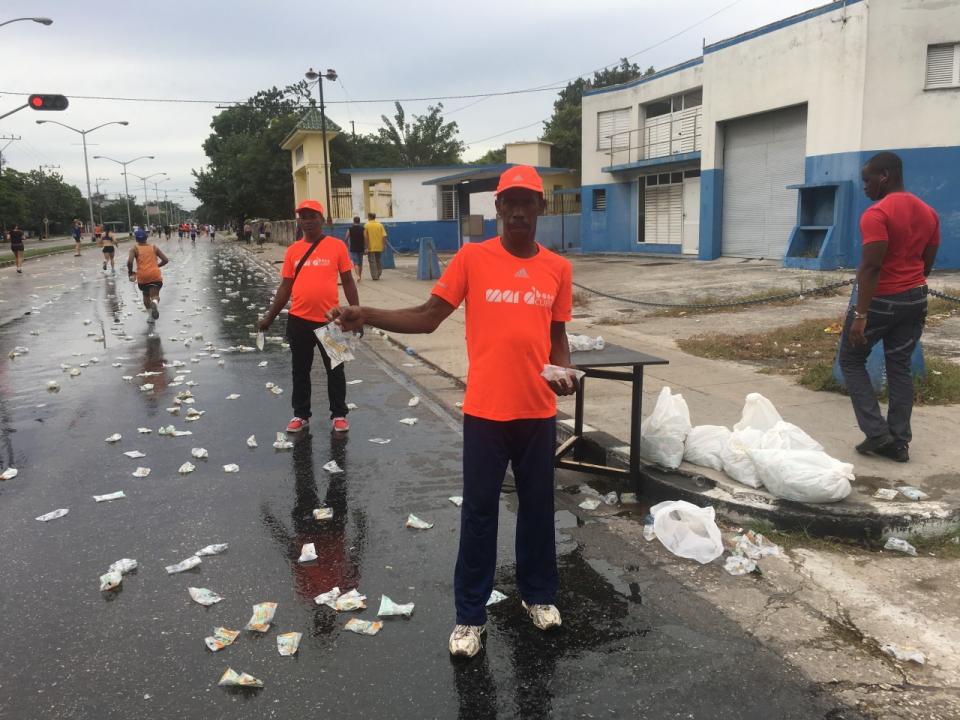
Volunteers along the course hand out sealed plastic pouches of water to the runners. (Photo: Lauren Johnston/Yahoo News)
It was easy to interact and travel through Cuba and never think of the long history of the harsh regime. The people I met were warm, friendly and eager to talk about the U.S. and the changes they hope to see in Cuba. People talked freely about economic hardships, but politics didn’t really come up. Handing over my passport to a stranger to be registered with the state within the first hour of my arrival triggered one of several jolts during the trip where I felt suddenly hyper-aware that this was still a communist country.
I’d had a similar moment driving from the airport to Cojimar. We passed billboard after billboard showing not product ads like the ones I see every day outside my office in Times Square, but pro-regime slogans, like the one that read, “BLOQUEO,” Cuba’s word for the trade embargo. The last “O” was an illustration of a noose with the tagline: “El genocidio mas largo de la historia,” or “the longest genocide in history.”
There was also the Saturday morning breakfast where Travieso let us know he’d heard there had been a terror attack in Paris, but that he didn’t have many details. In New York, I’m a breaking news editor and my phone buzzes with mobile alerts, texts and work chats almost every minute of every day. To learn that a terror attack had occurred the day before and that I’d missed 12 hours of developments was disorienting, and I suddenly felt far away and so cut off. I reached for my phone even though I knew I got no service in Cojimar. I tried and failed again to get cell service once we got to Havana. I didn’t see one newsstand or any televisions with news.
Finally later that afternoon I found a copy of the local, state-run paper, Granma, on the street. On the front page it ran a copy of a condolence email sent from Raul Castro to French President François Hollande. On page five, after pieces on Cuba’s success in preventing HIV, the U.S. secretary of agriculture and expanded Wi-Fi areas, the paper ran a report on the attack that killed 130 people.
Those were the moments that Cuba felt remote and separate. My marathon moments bridged divides.
After we ran past the stately, if weathered, buildings near the start, the race opened up onto the Malecon and for 5 miles or so we ran through bursts of saltwater spray as waves broke over the seawall, just the way I’d seen them in so many photos and in films like the “Buena Vista Social Club.” Something that had seemed romantic and unattainable for so long became real.
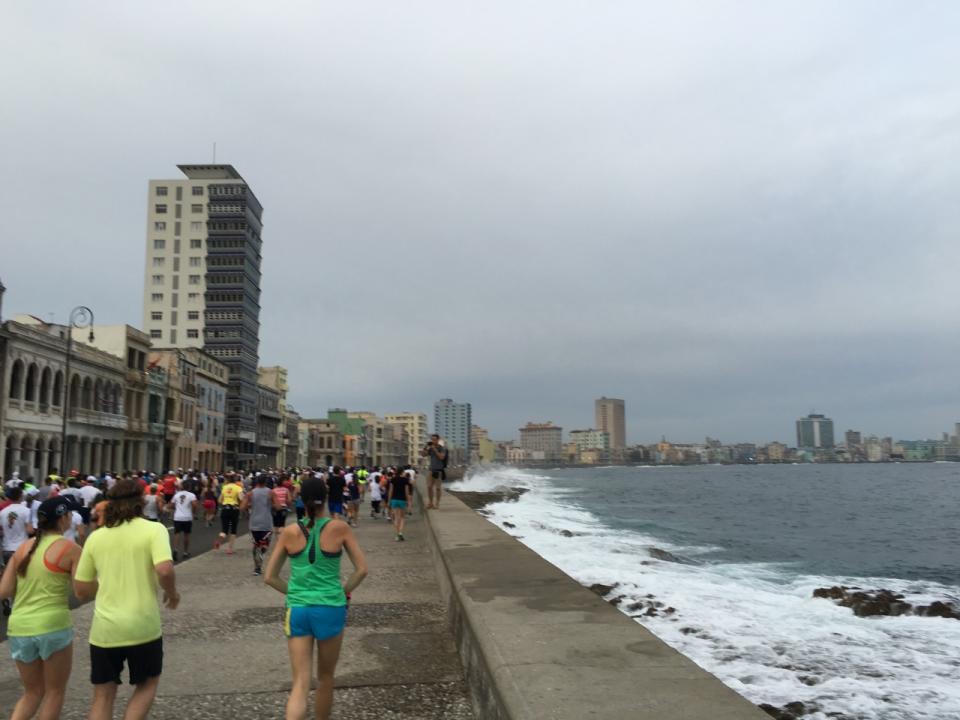
The first 5 miles of the race ran along Havana’s iconic oceanfront roadway, the Malecon. (Photo: Lauren Johnston/Yahoo News)
Once the course veered inland and into more residential areas, we saw more Cubans standing outside to watch, and sometimes cheer the race. Most looked curious and smiled back if I smiled. Some yelled, “Vamos, vamos!” or “Corre, corre!” Go, go! Run, run!
At one point my running partner (and cousin) Kate and I gave high-fives and thumbs up to three young boys along the course who had waved and given us a peace sign. We motioned them over to join us for a photo. They ran over smiling and lined up beside us, but seemed startled when we reversed the camera to selfie mode and they suddenly appeared on the screen. It seemed as though maybe they hadn’t seen a selfie before.
The air quality along the course was not great. As nostalgic as the old cars may seem to tourists, there are no emissions standards in Cuba and those rumbling pastel boats spit out a foul black exhaust that made each breath along the hot, humid course an effort. I’m not asthmatic and I do not walk during races, but I used the “just in case” inhaler my doctor gave me for the trip three times and might not have finished without it. And I walked the hills.
The water along the course was a novelty for me. Volunteers handed out plastic pouches we had to rip open with our teeth to drink. Some of the volunteers – who were many and unanimously friendly and supportive – were chipping chunks off big ice blocks to help keep us cool.
The roads were mostly blocked off for the race, and I’d see long lines of 1950s American-made roadsters waiting for the OK to cross during breaks in the waves of runners. I was alone for most of the second loop of the race since there were so few of us going the full distance. I almost felt invisible, slogging along among Cubans going about their regular shopping and errands.
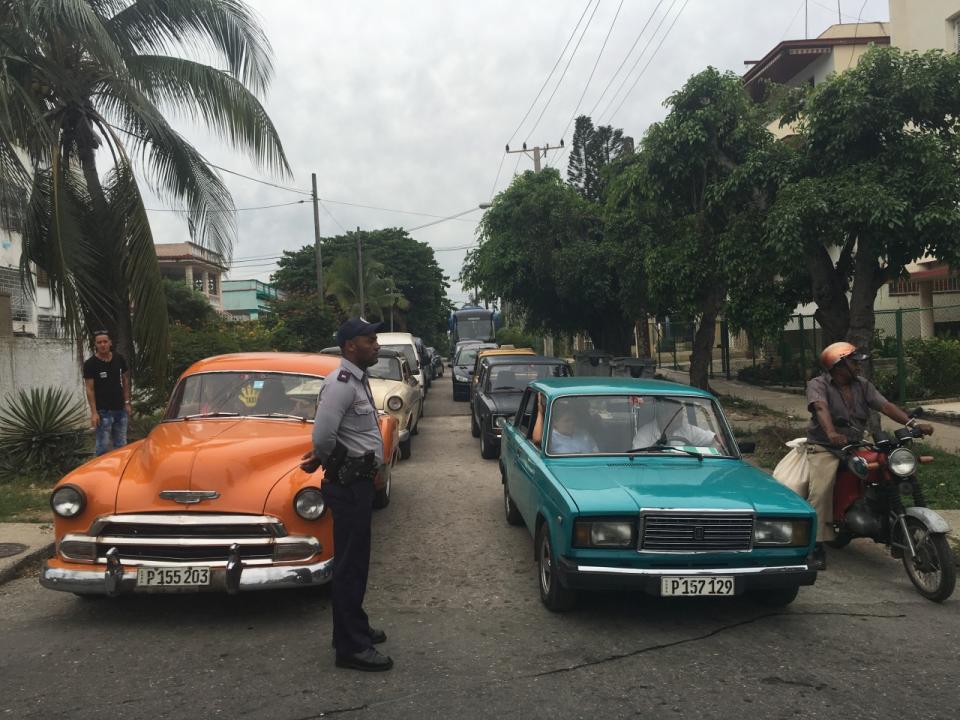
Police along the route stop drivers for the runners, letting the cars pass during breaks in runner traffic. (Photo: Lauren Johnston/Yahoo News)
When I got to a five-way intersection, there were no other runners nearby. A police officer halted traffic just for me, and I had a sensation during a race that I’ve never had and never will have again: I knew what the winners feel like — the elite runners who lead the pack the entire way with no bobbing huddle of heads to pull them forward.
Outside of the race, a moment that stayed with me is the night our waiter, Jose, joined our Tamales group for a drink. We ate breakfast and lunch each day at the same Cojimar “paladar,” the word for the small privately run restaurants. We made friends with the staff and that night we talked to Jose, 25, about WhatsApp, Instagram and the YouTube music revolution. He brought a laptop and small speaker. I was surprised to hear the same music I hear in New York: Bruno Mars, Chris Brown, Maroon 5, Pharrell and John Legend.
“But the Justin Bieber, I don’t like him,” Jose remarked.
We shuffled through a catalog of common pop culture references after that. I learned that Jose, his friends and the DJs at their local discotecas rely on YouTube to learn about American music and artists and to download songs. They know about streaming services like Pandora, but can’t use them due to poor Internet connections.
He said the CW show “Arrow” is popular with Cubans and that his girlfriend watches “Grey’s Anatomy.” And he wanted to know if my high school experience was anything like what he’d seen in the 1999 bro-comedy “American Pie.”
Then we all traded WhatsApp and Instagram handles and agreed to stay in touch, at least during the moments when Jose is able to visit Cojimar’s Wi-Fi hotspot.
Jose is hopeful about Cuba’s new relationship with the U.S., and he’d like to go visit his half-brother in Miami sometime soon. He called the opening up “the greatest thing for Cuba” and said that his friends and family had huddled around their televisions to hear the announcement last year.
“Raul came on TV and talked about Obama, and everybody was watching and was grateful, so much,” he said.
Before I left Cuba, I mailed myself a postcard from the famed former American mobster haven, the Hotel Nacional. I’ve been back nearly a month and it still hasn’t arrived. The morning my plane took off from Havana, I stared out the plane window watching the island recede. We’d barely completed our ascent before we were preparing for landing, and I was back on U.S. soil in less than an hour. I turned on my phone and in a symphony of beeps, pings and whooshes, a week’s worth of missed alerts, emails and texts burst onto my screen.
At the top of the list was a WhatsApp message from Jose that said, “Hello did you get well to U.S.?”
See more stories on this topic >>>


